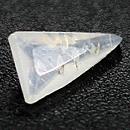|
|
||||||||||||||||
|
||||||||||||||||
|
||||||
|
|
|
|
Salammoniac
|
|
| | |
| Discovered in 1546; IMA status: Valid (pre-IMA; Grandfathered) | ||
|
| ||
|
Chemistry |
|
|
| |
|
NH4Cl | |
|
|
Ammonium Chloride |
|
Molecular Weight: |
53.49 gm |
|
Composition: |
Hydrogen |
7.54 % |
H |
— % |
Calc as (NH4)2O |
|
|
Nitrogen |
26.19 % |
N |
48.68 % |
(NH4)2O |
|
|
Chlorine |
66.28 % |
Cl |
66.28 % |
Cl |
|
|
|
— % |
Cl |
-14.96 % |
—O=Cl2 |
|
|
|
100.00 % |
|
100.00 % |
= TOTAL OXIDE |
|
|
|
||||
|
Classification |
|
|
| |
|
Halides | |
|
3/A.04-10 | |
|
|
3 : HALIDES |
|
Related to: |
n/a |
|
Varieties: |
None |
|
Synonyms: |
Chlorammonium, Chloride of Ammonium, Muriate of Ammonia, Sal-Ammoniac, Sal Ammoniac |
|
|
|
|
Crystal Data |
|
|
|
|
|
Crystals usually trapezohedral {112} modified by {113} at times; less commonly with gyroidal forms alone, or in combination. Dodecahedral; cubic (rare). Crystals often exhibit curved or stepped faces and may present a tetragnal or rhombohedral appearance due to suppression of faces and distortion. Skeletal or dendritic aggregates. Crusts or stalactitic masses; fibrous, earthy or mealy. |
|
|
On {111}, may be cyclic |
|
|
Parting: |
Translation gliding with T{011}, t[001] |
|
|
|
|
Physical Properties |
|
|
|
|
|
Imperfect on {111} |
|
|
Conchoidal |
|
|
Between brittle and sectile; very plastic |
|
|
1.5 - 2.0 |
|
|
1.532 (g/cm3) |
|
|
None |
|
|
Not Radioactive |
|
|
Other: | |
|
|
|
|
Optical Properties |
|
|
|
|
|
White, pale Gray, may be pale Yellow to Brown if impure; Colorless in transmitted light. |
|
|
Transparent |
|
|
Vitreous |
|
|
1.693 Isotropic; may be weakly anisotropic |
|
|
0.00 (Isotropic) Weakly birefringent at times, especially after mechanical deformation. |
|
|
n/a |
|
|
None |
|
|
|
|
|
Occurances |
|
|
|
|
|
Geological Setting: |
A sublimation product around volcanic fumaroles; in burning coal seams and waste piles; in guano deposits. The ammonia usually is derived from organic matter. |
|
Common Associations: |
Sulfur (fumaroles); Realgar, Orpiment, Sulfur, Mascagnite, Tschermigite (burning coal). |
|
Common Impurities: |
n/a |
|
Type Locality: |
possibly Etna, Vesuvius, Italy |
|
Year Discovered: |
1546 |
|
View mineral photos: | |
|
|
|
|
More Information |
|
|
|
|
|
| |
|
|
|
|
Salammoniac is
a sublimation product that forms around volcanic
fume release vents or fumaroles. The crystallization
occurs as volcanic gases escape. Another natural occurrence
is from underground burning coal seams. The ammonia
usually is derived from organic matter. Notable occurrences include Tajikistan; Mt.
Vesuvius, Italy; and Parícutin, Michoacan, Mexico. The
localtion most known for the unique "spine-like"
crystals is the former Ravat Village,
Yagnob River, Viloyati Sogd, Tajikistan. |
|
|
We
have not photographed our Salammoniac gems. Please
check back soon. |
